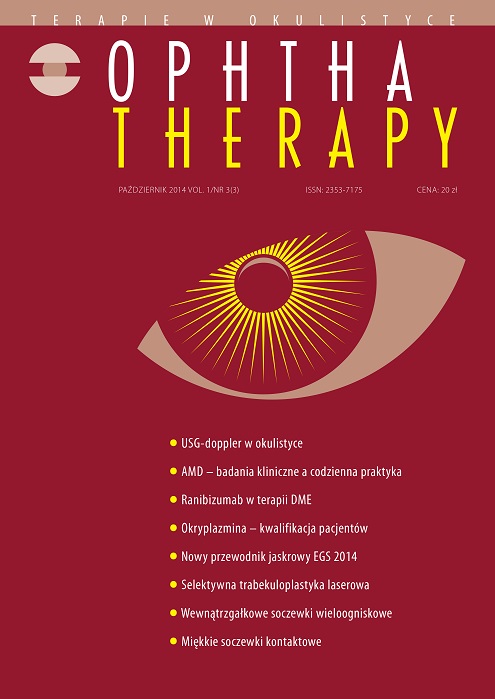Clinical research and everyday practice in wet form of age-related macular degeneration therapy – own experiences
Main Article Content
Abstract
Neovascular age-related macular degeneration (AMD) is the leading cause of irreversible visual acuity loss in individuals with this pathology and also one of the most important causes of legal blindness in Poland and other developed countries. The intravitreal injection of ranibizumab continues to be the standard of care for the treatment of wet AMD. This article presents the cases of patients treated with ranibizumab and observed over the years, who demonstrated permanent positive effect of the drug on the functioning and morphology of the macula. Based on the clinical research and academic publications to date the most common treatment algorithms with ranibizumab, applied in everyday retinal practice, are described.
Downloads
Article Details

This work is licensed under a Creative Commons Attribution-NonCommercial-NoDerivatives 4.0 International License.
Copyright: © Medical Education sp. z o.o. License allowing third parties to copy and redistribute the material in any medium or format and to remix, transform, and build upon the material, provided the original work is properly cited and states its license.
Address reprint requests to: Medical Education, Marcin Kuźma (marcin.kuzma@mededu.pl)
References
2. Boyer DS, Antoszyk AN, Awh CC. Subgroup analysis of the MARINA study of ranibizumab in neovascular age related macular degeneration. Ophthalmology. 2007; 114(2): 246-52.
3. Tano Y, Ohji M. EXTEND-I: safety and efficacy of ranibizumab in Japanes patients with subfoveal choroidal neovascularization secondary to age-related macular degeneration. Acta Ophthalmol. 2010; 88: 309-16.
4. Fung AE, Lalwani GA, Rosenfeld PJ. An optical coherence tomography – guided, variable dosing regimen with intravitreal ranibizumab for neovascular age-related macular degeneration. Am J Ophthalmol. 2007; 143: 566-83.
5. Lalwani GA, Rosenfeld PJ, Fung AE et al. A variable-dosing regimen with intravitreal ranibizumab for neovascular age-related macular degeneration: year 2 of the PrONTO study. Am J Ophthalmol. 2009; 148(1): 43-58.
6. Holz FG, Bandello F, Gillies M et al. Safety of ranibizumab in routine clinical practice: 1-year retrospective pooled analysis of four European neovascular AMD registries within the LUMINOUS programme. Br J Ophthalmol. 2013; 97: 1161-7.
7. Martin DF, Maguire MG, et al; CATT Research Group. Ranibizumab and bevacizumab for neovascular age related macular degeneration. N Engl J Med. 2011; 364: 1897-908.
8. Schmidt-Erfurth UM, Richard G, Augustin A et al. Guidance for the treatment of neovascular age-related macular degeneration. Acta Ophthalmol Scand. 2007; 85: 486-94.
9. Boyer DS, Heier JS, Brown DM et al. A phase III b study to evaluate the safety of ranibizumab in subject with neovascular agerelated macular degeneration. Ophthalmology. 2009; 116(9): 1731-9.
10. Holz FG, Amoaku W, Donate J et al. Safety and efficacy of a flexible dosing regimen of ranibizumab in neovascular age-related macular degeneration: the SUSTAIN Study. Ophthalmology. 2011; 118(4): 663-71.
11. Pushpoth S, Sykakis E, Merchant K et al. Measuring the benefit of 4 years of intravitreal ranibizumab treatment for neovascular age-related macular degeneration. Br J Ophthalmol. 2012; 96: 1469-73.
12. Mitchell P, Bressler N, Doan QV et al. Estimated cases of blindness and visual impairment from neovascular age-related-macular degeneration avoided in Australia by ranibizumab treatment. PLoS. 2014; 30: 9(6): e101072. online: https://doi.org/10.1371/journal.pone.0101072. eCollection 2014.
13. Avery RL, Castellarin AA, Steinle NC et al. Systemic pharmacokinetics following intravitreal injections of ranibizumab, bevacizumab or aflibercept in patients with neovascular AMD. Br J Ophthalmol. 2014 Jul 7. pii: bjophthalmol-2014-305252. online: https://doi.org/10.1136/bjophthalmol-2014-305252.

